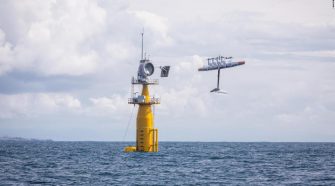Image source: The Motley Fool.
Geospace Technologies Corp (NASDAQ:GEOS)
Q4 2019 Earnings Call
Nov 22, 2019, 10:00 a.m. ET
Contents:
- Prepared Remarks
- Questions and Answers
- Call Participants
Prepared Remarks:
Operator
Welcome to the Geospace Technologies’ Fourth Quarter and Fiscal Year 2019 Earnings Conference Call. Hosting the call today from Geospace is Mr. Rick Wheeler, President and Chief Executive Officer. He is joined by Tom McEntire, the Company’s Vice President and Chief Financial Officer. Today’s call is being recorded and will be available on the Geospace Technologies’ Investor Relations website following the call. [Operator Instructions]
It is now my pleasure to turn the floor over to Rick Wheeler. Sir, you may begin.
Rick Wheeler — President and Chief Executive Officer
Thank you, Katherine. Good morning everyone and welcome to Geospace Technologies conference call for the fourth quarter of our 2019 fiscal year. I’m Rick Wheeler, the Company’s President and Chief Executive Officer, and I’m joined by Tom McEntire, the Company’s Vice President and Chief Financial Officer, along with Robert Curda, the Company’s Operational Controller.
I’ll start the call with an overview of the fourth quarter and Tom will then offer an in-depth commentary on our financial performance. Afterwards, I’ll make a few final remarks and then we’ll open the line for questions. Some of today’s statements may be considered forward-looking as defined in the Private Securities Litigation Reform Act of 1995, including comments about product markets, revenue recognition, planned operations and capital expenditures. These statements are based on our present awareness, while our actual outcomes are affected by uncertainties and other factors we cannot control or predict.
Both known and unknown risks can lead to undesirable results or performance differences from what we say or imply today. Such risks and uncertainties include those discussed in our SEC Forms 10-K and 10-Q filings. For convenience, we will link a recording of this call on the Investor Relations page of our geospace.com website. Note that information discussed this morning is time sensitive and may not be accurate at the time one listens to the replay. Yesterday, after the market closed, we released our financial results for the fourth quarter and fiscal year ended September 30th, 2019. As reported, revenue was driven in the fourth quarter and throughout the year by a growing number of rental contracts, utilizing our OBX ocean-bottom nodal seismic recorders.
In the fourth quarter revenue surged to $28.9 million and gross profit rose to $10.4 million, both amounts reflect the highest quarterly figures in more than five years. For the full year ended September 30th, 2019 revenue reached $95.8 million and gross profit nearly tripled to $31.4 million. The improved results in both revenue and gross profit are attributed to our growing rental equipment business. Both our fourth quarter and full year results benefited from two favorable, but unusual events. The first is a $7 million gain on the sale of non-essential real estate. And the second is a net reduction of $2.1 million and earn out liabilities related to our acquisitions of Quantum and OptoSeis.
This net adjustment to contingent consideration necessarily flow through the income statement as a charge to operating expenses. If we exclude these favorable adjustments on a pro forma basis, our 2019 fiscal fourth quarter and full-year losses were $0.04 per share and $0.70 per diluted share for the quarter and year respectively. Our oil and gas market segment produced $20.8 million in revenue for the fourth quarter and over the full fiscal year generated $65 million in revenue. The increases of 57% and 45% respectively over the equivalent three and 12-month periods a year ago were dominated by our wireless products. As highlighted earlier, this is due to increased rentals of our OBX marine nodal recording systems. At year-end, we had more than 31,000 OBX stations in our rental fleet, most of which were being utilized on multiple rental contracts with multiple seismic contractors.
As discussions occur with new and existing customers for future OBX rental contracts and extensions to current contracts, we carefully evaluate possible needs for expansion of our OBX rental fleet to satisfy the anticipated growth in demand. We also note that revenue in the fourth quarter from our wireless products was augmented by the sale of 5,000 channels of GCL-1 land recording system to a European contractor. And as recently announced, we expect to fulfill delivery of another order of 30,000 GCL-1 stations early in our second fiscal quarter, which ends March 31, 2020. Our traditional seismic products produced revenue of only $600,000 in the fourth quarter, a historic low for these products. And for the year, revenue of $9.5 million represents a decrease of 26% from last year.
Lower revenue in both periods is due to lesser demand for our seismic sensors, which was partially offset for the full year period by higher revenue from our marine products. Revenue from our reservoir seismic products for the fourth quarter was only $252,000 and for the year totaled $2.7 million. These reflect respective decreases from their prior comparative periods of 13% and 44% stemming from lower sales and rentals of our borehole tools and fewer services. We expect revenue from this product segment to remain low, unless and until we have a contract for the delivery of a permanent reservoir monitoring or PRM system. We extended our PRM product offerings in November of 2018 through our acquisition of OptoSeis, fiber optic sensing technology and we believe this augmented product line along with our prevalent leadership and PRM system design enhances our opportunities to receive future contracts.
Currently, there are no such contracts up for award, but we are in discussions with multiple oil and gas companies interested in utilizing this technology. Note that as a result of these expanded discussions, we recorded a charge of $0.8 million in the fourth quarter, increasing the fair value of the earn-out liability we expect to pay the previous owner of OptoSeis. We also believe the climate of current discussions indicates that a tender for a PRM system is likely in the foreseeable future. But we do not expect to earn any revenue if awarded contract until late in fiscal year 2020 or beyond. Revenue from our adjacent market segment totaled $8 million in the fourth quarter. This increase of 70% over last year’s fourth quarter was primarily due to higher sales of our industrial sensors and water meter cables, aided by slight increases in revenue from graphic image products and contract manufacturing services.
Total revenue for the full fiscal year from this segment was $30.2 million. This represents an essentially flat year-over-year performance, comprised of revenue reductions from water meter cables balanced by offsetting increases from industrial sensors and with relatively unchanged revenue from other contributing products. We believe our adjacent market segment provides a strategic element of revenue stability amid the high volatility experienced by our oil and gas market segment products. We also believe this segment continues to exhibit overall revenue growth opportunities despite fluctuations that may occur from one period to another. Revenue from our emerging market segment totaled $14,000 in the fourth quarter and $159,000 for the full fiscal year ended September 30, 2019. These figures reflect respective decreases of 95% and 44% from the same period last year, which are attributed to completions of work for legacy contracts that occurred last year compared with no significant border or perimeter security contracts during fiscal year 2019.
This market segment is comprised solely of products and services offered by Quantum, which focuses on specialty products incorporating seismic acoustic technology to monitor monitor, protect and secure physical borders and perimeters in both domestic and international markets, while significant revenue contributions from Quantum are not expected in the near term, we believe this unique technology is still capable of creating meaningful future revenue for border and perimeter security system contracts. Since Quantum has not received any meaningful border and perimeter security contract since its acquisition in July of 2018, we reduced the fair market value of our earn-out liability by $2.9 million resulting in an offsetting $2.9 million credit or reduction through our operating expenses.
At this point, I will now turn the call over to Tom for some more financial details.
Thomas McEntire — Chief Financial Officer
Thank you, Rick and good morning everyone. Before I begin, I’d like to remind everyone that we will not be providing any specific revenue or earnings guidance during this morning’s call. In yesterday’s press release for our fourth quarter ended September 30th, 2019, we reported revenue of $28.9 million compared to last year’s revenue of $20.6 million. Net income for the quarter was $8.7 million or $0.63 per diluted share compared to last year’s net loss of $207,000 or $0.02 per diluted share. For the year ended September 30, 2019 we reported revenue of $95.8 million compared to revenue of $75.7 million last year. Our net loss for the year was $146,000 or a loss of $0.01 per diluted share compared to last year’s net loss of $19.2 million or $1.45 per diluted share.
Both of the 2019 fiscal year and fourth quarter periods benefited from a $7 million gain for the sale of non-essential real estate and a $2.1 million net reduction to the fair value of contingent earn-out liabilities related to our recent acquisitions of Quantum and OptoSeis. Excluding these favorable adjustments for the fourth quarter of 2019, the company would have reported a net loss of $500,000 or $0.04 per diluted share. And the full year would have resulted in a net loss of $9.3 million or $0.70 per diluted share. For comparative purposes the company also noted that the fourth quarter of fiscal year of 2018 benefited from the reversal of the $2.3 million bad debt that was previously established in the third quarter of fiscal year 2018.
A breakdown of our oil and gas product revenue was as follows. Our traditional product revenue for the fourth quarter was $600,000, a decrease of 82% compared to revenue of $3.3 million last year. Revenue for the year was $9.5 million, a decrease of 26% compared to last year’s revenue of $12.9 million. The revenue declines in both periods are attributable to lower demand for our sensor products in the year long period, these decreases were partially offset by increased marine product revenue.
For wireless product revenue for the quarter was $20 million, an increase of 106% compared to revenue of $9.7 million last year. For the full year, wireless product revenue was $52.8 million, an increase of 94% compared to $27.3 million in the prior year. These increases were the result of substantial growth in the rental of our OBX marine nodal systems. Our Reservoir product revenue for the fourth quarter was $252,000, a decrease of 13% compared to revenue of $290,000 last year.
Revenue for the full year was $2.7 million, a decrease of 44% compared to revenue of $4.8 million last year. This revenue decrease for both periods primarily reflects reduced sales of rentals of our borehole tools and reduced demand for our support services. We do not expect meaningful revenue from these products unless and until we are engaged in the contract for the delivery of a permanent reservoir monitoring system. We are, however, as Rick said, in discussions with multiple oil and gas companies interested in using our PRM technology. As a result of these discussions, we recorded a charge of $800,000 to our operating expenses in the fourth quarter to increase the fair value of the earn-out liability, we expect to pay to the previous owner of OptoSeis.
Moving onto our adjacent market segment, our industrial product revenue for the fourth quarter was $5.3 million, an increase of 23% compared to last year’s revenue of $4.3 million. This increase was primarily due to higher sales of our industrial sensors and water meter cables. Revenue for the year was $18.3 million compared to last year’s revenue of $18.4 million. The slight decline in revenue resulted from lower sales of our water meter products with an offsetting increase in demand for our industrial sensor products. Imaging revenue for the fourth quarter was $2.8 million, an increase of 6% compared to last year’s revenue of $2.6 million. Revenue for the full year was $11.8 million, an increase of 2% compared to $11.6 million in fiscal year 2018. These increases were caused by improved sales of our equipment and film products.
Finally, revenue from our emerging market segment totaled $14,000 and $159,000 respectively for the three months and full year ended September 30th, 2019. Prior year revenue was $286,000 for both the fourth quarter and full-year due to our acquisition of Quantum in July 2018. While we do not anticipate significant revenue contributions from Quantum in the near term, we do believe our ongoing efforts are creating future meaningful revenue opportunities. Since Quantum has not yet received any significant border and perimeter security contracts we reduced, the fair value of our earn-out liability by $2.9 million resulting in an offsetting $2.9 million credit or reduction to our operating expenses. Our consolidated gross profit for the fourth quarter was $10.4 million an increase of 98% compared to $5.3 million last year.
Gross profit for the year was $31.4 million, an increase of 186% compared to $11 million last year. The improvement in our gross profit resulted from a significant increase in OBX rental revenue and a decline in underutilized factory capacity due to the higher manufacturing productivity we realized from our increased production activities. When analyzing our 2018 and 2019 Operating expenses, we have removed the impact of the $2.1 million net adjustment recorded in our fourth quarter of 2019 to adjust the fair value of contingent earn-out consideration related to the acquisitions of Quantum or OptoSeis. And a $2.3 million bad debt reversal in the fourth quarter of 2018.
After removing these adjustments, our 2019 Operating expenses for the fourth quarter were $10.2 million, an increase of 22% compared to $8.3 million last year. Our 2019, operating expenses for the full year were $39.6 million, an increase of 25% compared to last year’s operating expenses of $31.7 million. The increase in operating expenses for both periods resulted from the incremental operating costs associated with our recent acquisitions of Quantum or OptoSeis included intangible asset amortization expenses.
Fiscal year 2019 cash investments into our rental fleet and property, plant and equipment were $34.1 million and $1.9 million respectively. We are estimating the total fiscal year of 2020 capital investments into our rental fleet and property plant and equipment will be [Indecipherable] respectively. Our rental fleet investments will be closely tied to market demand for our OBX technology. At September 30th, 2019, we had $8.5 million of accounts receivable, due from a large international customer, who is currently leasing a significant portion of our OBX nodal equipment. We have experienced ongoing cash collection difficulties with this customer throughout fiscal year 2019.
Just this month, we accepted a payment plan from this customer to bring our unpaid invoices to a satisfactory status. This plan is expected to be completed during our second fiscal quarter ending March 31st, 2020. While, we have significant concerns about the ultimate collection of these receivables, we have not and do not intend to provide any significant bad debt reserves toward this customer’s outstanding accounts receivable unless and until we believe that in our judgment, it is probable, the customer will not be able to pay it debts to us. Our balance sheet at September 30th, 2019 reflected almost $19 million of cash and cash equivalents. We have no long-term debt outstanding in the borrowings under our credit facility or available borrowings under the credit facility with $27 million. We are pleased to say that our credit agreement with Frost Bank was recently extended to expire in April of 2022. In August, 2019, we sold a non-essential real estate property for $8.3 million and recognized a $7 million gain in the fourth quarter. The majority of our remaining real estate holdings are owned free and clear and without any leverage.
Finally, you may have noticed in yesterday’s press release that I plan to retire from Geospace at the end of this calendar year. During my 22-year career as a CFO at Geospace, I’ve been very blessed to work with a wonderful cast, bright minds and capable business leaders. Today, I’d like to introduce you to Robert Curda, who will assume the role of Vice President and Chief Financial Officer effective January 1st. Robert is also a capable later, and I’m extremely confident in Robert’s financial abilities. I know that Robert will support Rick in our Board of Directors and our shareholders with the professionalism, you would come to expect from CFO. So Robert, I will turn the microphone over to you.
Robert Curda — Operational Controller
Thanks, Tom. And I’m excited about the Chief Financial Officer opportunity at Geospace. During my 15-year career at Geospace, Tom has created an excellent environments to prepare me for the additional responsibilities and duties as a CFO. What I have learned from Tom over the years will serve me well in this position. Thank you, Tom for mentoring and preparing me for this role. Also, Rick and I are looking forward to working with Tom in consultative manner in the future.
I now turn the call over to Rick for his final comments.
Rick Wheeler — President and Chief Executive Officer
Thanks, Robert. And Tom, let me just add to Robert’s comment that Tom has performed as the Company’s CFO for 22 years with the utmost tenants of integrity and transparency. And this [Indecipherable] is exhibited throughout our financial staff. I am very confident that Robert and all of our staff will continue in this great tradition providing both our shareholders and our customers with the best-in-class performance they’ve come to know.
We will engage Tom as a consultant from time to time is may be needed. So we really haven’t seen in the last of them, but as both a personal friend and professional colleagues, we wish him the absolute very best in his retirement. So back to the business hand. It is notable that certain product lines within our oil and gas market segment continue to experience persistent commercial challenges and this is highly evident for our traditional exploration in reservoir seismic product categories.
In contrast, revenue from our wireless seismic products continues to strengthen, driven by an expanding list of rental contracts and global projects utilizing our ocean bottom OBX nodal systems. And although demand for our wireless GSX land products has diminished in recent years due to reduced onshore seismic exploration, the recent orders of our GCL land wireless systems give us confidence that our advanced new technology offers the best shows and value to our customers in this very difficult market.
We’re also encouraged by our ongoing discussions with oil and gas companies regarding the deployment of PRM systems. Many of these plans call for timelines of two to three years and could be postponed even further depending on future capital spending budgets. However, the long-term value of PRM systems is well established and we are glad that such dialogs our reestablished and moving forward.
Meanwhile, we will continue pursuing our diversification strategies by expanding the product lines within our adjacent market segment and readying our border and Perimeter Security solutions developed through out integration of Quantum. This concludes our prepared remarks and I’ll now turn the call back over to Katherine for questions.
Questions and Answers:
Operator
[Operator Instructions] Our first question will come today from David Nierenberg with Nierenberg Investment Management Company. Please go ahead.
David Nierenberg — Nierenberg Investment — Analyst
Good morning, guys.
Thomas McEntire — Chief Financial Officer
Good morning, David.
Rick Wheeler — President and Chief Executive Officer
Good morning.
David Nierenberg — Nierenberg Investment — Analyst
Thank you for your service to the company and the stakeholders particularly your accomplishments of protecting the Company’s balance sheet through a terrible industry downturn, you’re pruning the costs of the Company to further conserve cash and your shrewd structuring of the two recent acquisitions to further protect the balance sheet and to put the performance risk on the sellers rather than the shareholders. So thank you for doing all of those things.
Thomas McEntire — Chief Financial Officer
Yeah, thank you, David for those kind comments. I appreciate it.
David Nierenberg — Nierenberg Investment — Analyst
The only blemish I can ask you about and I’ll start with this and then go on to a couple of other questions is, do you think that changes in credit evaluation of prospective customers or credit monitoring of existing customers should be implemented in light of this latest disclosure about the risks associated with collecting the $8.5 million of accounts receivable?
Thomas McEntire — Chief Financial Officer
Davis, that’s a good question. We do have internal programs for monitoring credit and given out credit and there is many decisions that are made, along with those credit, that credit analysis, and those decisions include deploying equipment that is currently inactive and taken a risk to get the equipment out into the market with the customer to produce revenue even though the customer might not be the best customer there is. And so we look at all of that, when we’re doing there and we’re not afraid to call in the equipment, if we have to, and we don’t want to do that. We want to try to work with the customer that I referred to, and we’re going to work with them, but if it doesn’t work out, we’re going to recall the equipment and get it redeployed somewhere else.
David Nierenberg — Nierenberg Investment — Analyst
I’d like to ask you one other question, Tom, and that is that the $800,000, if I can call it a mark up of the potential payable to the sellers of OptoSeis, is an interesting and I think a very positive development. I wonder if you could amplify on that please for us to help you understand the reason why your audit committee and you’re outside auditors and you were comfortable taking that mark up?
Thomas McEntire — Chief Financial Officer
Yeah, good question, David and just for everybody else that’s on the phone, the accounting here is kind of counter-intuitive. The good news is resulting in a charge to the financial statements and the bad news is resulting in gain on the income statement. But we utilize an outside service firm to help us come up with that estimate. We’re not staffed internally to be able to really have the abilities and skills to do that and so it’s all based on projections and estimates and future revenues and discussions that are going on and the timing of those discussions and a whole lot of different variables and so when our advisors came up with the number, of course, I was discussed deeply at the audit committee level and with our external accountants and so we agree with it. We’re comfortable with it and we’re going to move forward with it.
David Nierenberg — Nierenberg Investment — Analyst
Well, that’s great. It’s not a big number, but it’s a positive development. And it is in contrast to the $2.9 million adjustment the other way with respect to Quantum and that triggers, I’d say, my final question. Rick, your concluding comments highlighted three important growth opportunities in the core business, continuation of OBX rental business, the new GCL land wireless system and ongoing discussions and hopes about renewed PRM business, that’s nice to have the potential of three different parts of the core business firing at the same time. In light of that, I hope that without a demotivating the team in Quantum, you might motivate them to do better than $14,000 of revenue in the quarter because you’ve got a capital allocation issue ahead of you of three parts of your core business have the potential to grow the question becomes, why does it make sense to play venture capitalist with Quantum?
Rick Wheeler — President and Chief Executive Officer
Those are all very good points Dave and the fact is we by no means have given up on the opportunities that are represented with Quantum. Certainly from an accounting principles point of view, these adjustments were necessary and were appropriate to make, simply because the expectations of any contracts have been pushed out, largely dealing with the government in many of these cases has bearing on all of that.
And at this point in time as you will know the government sometimes move things well to the right, but I can tell you that the development efforts and the technology that we have co-developed with Quantum during this period, since we acquired them over this year, we’ve demonstrated functionality to those interested parties, that has never been able to be shown before. So, we have created something that is unique and very well received. So we really do believe the opportunity still remain there and very strongly. It’s a matter of timing and we fully expect those to manifest as we sit here today.
Thomas McEntire — Chief Financial Officer
Hi David, this is Tom. I would also add to Rick’s comment that the Quantum opportunities haven’t disappeared. Rick indicated, they’ve really been pushed out to the right. And Quantum has a four-year earn out period and they’re more than a year into it. So they have less than three years left and so as these projects get pushed out or potentially pushed out to the right, we have to lower that earn-out liability because we might get the revenue, but it might fall out of the earn out period. So that’s a lot to do with why there’s a negative adjustment on Quantum.
David Nierenberg — Nierenberg Investment — Analyst
One risk about what you call, moving out to the right, is it, it’s not only a calendar risk, moving to the right is also a political risk at the same time.
Thomas McEntire — Chief Financial Officer
No doubt about it.
David Nierenberg — Nierenberg Investment — Analyst
Fun intended, I guess the main thing is that you feel good about the growth drivers in OBX, GCL and PRM and that’s what’s going to be our bread and butter for the foreseeable future and let’s hope you get the lift that you anticipate?
Thomas McEntire — Chief Financial Officer
Absolutely right.
David Nierenberg — Nierenberg Investment — Analyst
Thank you.
Rick Wheeler — President and Chief Executive Officer
Thank you.
Operator
Our next question comes from Bill Dezellem with Tieton Capital. Please go ahead.
Bill Dezellem — Tieton Capital. — Analyst
Thank you. First of all, I would like to sincerely echo David’s comments and I have absolutely nothing to say other than repeat what he said, so thank you for for keeping the balance sheet as good as you have. Let me shift to my questions, the GCL, congratulations with the orders — for me, it seem to be coming a little bit out of less field given that you all have been very conservative with your comments on the last several calls about land-based systems, would you please talk about how, not only the orders this quarter, but the larger one that you announced last week, how those developed?
Rick Wheeler — President and Chief Executive Officer
Sure. The first order had been something that we have been discussing with that European contractor actually for quite some time, but that order as well as this more recent quarter were all driven by contract negotiations those contractors were having with their end clients, and so there was a necessary activity for those to close in order to make these purchases make sense for them. So largely it was — there were those contingencies were fulfilled and hence why these orders have finally manifested. So the discussions do occur, but we have discussions all the time and there is no reason to sort of portray those discussions earlier on with lots of credibility toward manifesting, because many of them do not. In this particular case they did and we’re very appreciative of that and certainly, we really do feel that our technology, which we were careful to develop even during downtimes represents extreme value even in a circumstance, where the commerce is limited at this point in time. So, that we would remain the best choice. So it’s really — we’re into other discussions as well, but there is no strong evidence that some of those may manifest either, but if and when they do, we would certainly make those known.
Bill Dezellem — Tieton Capital. — Analyst
Rick, are the number of conversations, even if you’re not convinced that they are going to develop into anything — are the number of conversations increasing on the land-based GCL?
Rick Wheeler — President and Chief Executive Officer
Not by incredible numbers. I mean, they exist, but I’m not going to tell you that we’re having to — cool off the telephone as it’s ringing or anything like that.
Bill Dezellem — Tieton Capital. — Analyst
Understood. But, it does imply, if you at least have an equal number that we could those conversations, those contractors could end up winning business, which could end up leading to you having notes to deliver?
Rick Wheeler — President and Chief Executive Officer
Right. But certainly, and you — I’m sure are very well aware of this, the onshore seismic activities are at significant low levels at this point in time and the number of contractors out there has been reduced and you have — your major players out there functioning right now and they tend to have all the equipment they need for their current demands. We’re ready, able and whenever they need assistance or help in shoring up their equipment needs, we’re there to support them and we’re ready at any time. But as you know, the limited — the amount of Commerce is limited right now.
Bill Dezellem — Tieton Capital. — Analyst
Great, thank you. And the gain on sale was at the [Indecipherable] facility.
Rick Wheeler — President and Chief Executive Officer
It was.
Bill Dezellem — Tieton Capital. — Analyst
Okay, thank you. And then let me switch, if I may to border security. What still needs to be done with the integration of the Quantum software and artificial intelligence, machine learning with your — with your seismic hardware?
Rick Wheeler — President and Chief Executive Officer
Very little from a functional standpoint, there are some next phase types progression in that integration from a technology point of view, that we certainly have on our roadmap going forward, but there is not, it’s mainly tying a bow around things at this point with respect to how the integration has progressed to present and it’s ready to go.
Bill Dezellem — Tieton Capital. — Analyst
All right, and then I’d like to tell you a couple of things together with — further with the border security. First of all you — so you had said that you have demonstrated the functionality to the outside, you didn’t say who, but demonstrated that functionality. So would you please talk us through who you are referring to, whether that be agencies or countries are or whomever? And what sort of functionality hasn’t been demonstrated before that you all were able to demonstrate?
Rick Wheeler — President and Chief Executive Officer
Well, I can’t get into all of those details, but certainly it’s primarily governmental agencies and domestic once at that, that our conversations have been with. As far as the exact functionalities, again even some of that is rather kept close to the vest. But what we can say is that the abilities for these systems to detect particular aspects of activity that are occurring, where there are occurring and the nature of those events is pretty remarkable and that’s the sort of aspects of technology that we’ve been able to demonstrate.
Bill Dezellem — Tieton Capital. — Analyst
Rick, I don’t want us all to require a security clearance to be able to understand more, but your comments were pretty vague. Would you be able to give us an example of what you were referring to there?
Rick Wheeler — President and Chief Executive Officer
Well, there is a certain amount of artificial intelligence. It’s applied to examining these seismic signals that come to play. And you can well imagine that most security is monitored through visual means, cameras and other things of that nature. The problem is there is often ways of defeating cameras and if you’re in an environment it’s foggy or night time or in other ways of controversy visibility, that’s problematic. And when you’re dealing with tunnels, there is no visibility whatsoever. However, the ability for us to perform analysis of seismic events and as you well know, you might be able to support cameras with tunnels and other types of similar activity, but you can’t do anything without making noise or otherwise inducing some seismic for those activities. The ability to detect those without notice and call out through the appropriate intelligence what those events represent, what type of activities occur that they represent and where there are — they are occurring is uniquely something that the integration with Quantum technology has provided.
Bill Dezellem — Tieton Capital. — Analyst
And how many, how many different agencies or organizations are you talking with?
Rick Wheeler — President and Chief Executive Officer
I’m not going to tell you that Bill.
Bill Dezellem — Tieton Capital. — Analyst
How about [Speech Overlap].
Rick Wheeler — President and Chief Executive Officer
I think there is a whole chain of command of agencies within the government and different branches of the government that these conversations are taking place with.
Bill Dezellem — Tieton Capital. — Analyst
Okay. So it’s not just a single not — not a single agency then?
Rick Wheeler — President and Chief Executive Officer
No, not at all.
Bill Dezellem — Tieton Capital. — Analyst
And what about actual tests that you have done? Have you done any actual test and if so what was the result relative to what the organization, you were testing for has seen with other vendors?
Rick Wheeler — President and Chief Executive Officer
The test, have been performed and the results have never been demonstrated before by any other system.
Bill Dezellem — Tieton Capital. — Analyst
Okay. One additional question please. Relative to the federal government and really, I’m thinking the President’s attention seems now to be most focused on trade rather than a border wall or border security, has that public shift in the commentary coming out of the White House, has that had any impact on your discussions with the agencies that you’ve been talking with?
Rick Wheeler — President and Chief Executive Officer
If it has had an impact. It’s not one that has manifested in any overt way, keeping in mind that monitoring of activity around the border is important to both parties, to both sides of the aisle, because there isn’t homeland security aspects associated with making sure that our population is safe and that there are nefarious activities taking place through tunneling or other activities. So that’s important to all parties.
Bill Dezellem — Tieton Capital. — Analyst
So this is not a phenomenon where its election year next year, and we do worry about a change or not a change in the White House. This is non-political party related?
Rick Wheeler — President and Chief Executive Officer
That’s correct. There is advocacy on both sides and out of both parties.
Bill Dezellem — Tieton Capital. — Analyst
Thank you. And one more here if I — actually a couple more. First of all, over the course of the next, say three years, would you expect a greater contribution from PRM or a greater contribution from border security? At the moment I recognize it’s like having two turtles at the starting line and which one is going to go five miles, but I’m still asking the question.
Rick Wheeler — President and Chief Executive Officer
Right. Well, I mean there is really no way to predict that sort of thing, there is variability that occurs in the discussions on both sides and delays that occur in both sides. I think, they both have equal probabilities of manifesting significantly.
Bill Dezellem — Tieton Capital. — Analyst
Do you think both of them could be meaningful and given that historically PRM has been bigger when there was business, it had been quite large and bigger than land or OBX, is the implication that we could have both border security and PRM being larger than your OBX and GCL businesses?
Rick Wheeler — President and Chief Executive Officer
That’s easily possible.
Bill Dezellem — Tieton Capital. — Analyst
Okay. And then one additional question. And, I promise I’ll step back. The southern Mexican border, has the Mexican government expressed any interest or do you see that as a potential because I recall a few months ago, that was a hot button with the President wanting to see that border sealed up?
Rick Wheeler — President and Chief Executive Officer
Well, I’m sure there’s interest and I know there’s interest down there, as far as the Mexican government’s participation in that interest, that’s not something that would directly engage us, but would be engaged through our own government in that situation.
Bill Dezellem — Tieton Capital. — Analyst
Great, thank you for taking all the questions.
Rick Wheeler — President and Chief Executive Officer
You bet.
Operator
[Operator Instructions] We’ll now go to [Indecipherable] from Mirac, Inc. [Phonetic]. Please go ahead.
Mirac, Inc. — Analyst
Good morning all of you.
Rick Wheeler — President and Chief Executive Officer
Good morning.
Thomas McEntire — Chief Financial Officer
Good morning.
Mirac, Inc. — Analyst
I have question about three different areas. I have the OBX question and then one related to the PRM business and finally, one to the balance sheet. For OBX rental business, from what I understand, you now have more than 31,000 units in your rental fleet. And I am wondering, are you still building nodes and do you have any estimates for, how many in nodes you will build in addition to the ones you have now?
Rick Wheeler — President and Chief Executive Officer
We are still building some nodes to complete our initial goals for inventory of those in our rental fleet. At this point in time, we’re at the tail end of those new constructions. We don’t have immediate plans to go build a significant number more, but I can tell you that we are having discussions with both new customers and some customers that are already renting under contract, our OBX where they are negotiating additional contracts with their clients, with the premise and if and only if the additional OBX might be made available. So we will be evaluating the length of those contracts, the viability of those contracts to determine it perhaps we might need to increase that rental fleet size a little more, but we’ll be very cautious about that.
Mirac, Inc. — Analyst
Okay, excellent. So can you say anything about the level of utilization you expect on your rental tool going forward in the next quarters, I’m thinking primarily on what utilization the existing contracts will give, but also they on the existing contracts, you have in the estimate for the utilization of the rental tool?
Thomas McEntire — Chief Financial Officer
Yeah, hi, this is Tom. Right now, we’re pretty close to 90% utilized on our OBX fleet and we would expect that to continue through the next quarter.
Mirac, Inc. — Analyst
Okay. And beyond that?
Thomas McEntire — Chief Financial Officer
Beyond that, we’re not really giving any guidance, it’s hard to say. We do have contracts that go beyond the first quarter, but we’re in the process of also trying to renew some contracts. So difficult to say, but we certainly don’t see demand falling off significantly and we would expect the trend up pretty much continue.
Mirac, Inc. — Analyst
Okay, excellent. Thank you. So I have a question about the PRM market segments through and based on what you’re kind of have the feeling for at the moment. What’s happened with regards to the margins for this business area for future contract, I’m thinking that there has been kind of almost the repricing of everything in the market and you have some historic PRM contract deliveries, but what about the margins going forward? Can you say anything about that?
Rick Wheeler — President and Chief Executive Officer
Well, there is always pressure on margins as you will — can imagine. The oil companies are very fastidious about examining their costs for these sorts of things. We still believe the margins are significantly in our favor in terms of involving ourselves in that commerce, otherwise, we wouldn’t even be having these discussions. But we don’t really give those margins specifically as a form of guidance or other types of information that lend themselves to that, but we still think it’s beneficial to us to pursue these.
Mirac, Inc. — Analyst
Very good. Finally, for the balance sheet, is the ratio between the book value and the sales price for the real estate that was sold, is that representative would attribute within book value and market value for the real estate currently on the balance sheet?
Thomas McEntire — Chief Financial Officer
We don’t go in [a price or real estate, but I would suspect that there is certainly a difference and we probably have built in gains on most of our real estate, but I couldn’t even begin to estimate what that is.
Mirac, Inc. — Analyst
Okay, thank you very much. That’s all from me. You guys have a nice day.
Rick Wheeler — President and Chief Executive Officer
Thank you.
Thomas McEntire — Chief Financial Officer
Thank you.
Operator
And we’ll now take a follow-up from David Nierenberg with Nierenberg Investment Management Company. Please go ahead.
David Nierenberg — Nierenberg Investment — Analyst
Given the uniqueness of the border monitoring capability that you have, would you require some sort of export control approval to sell it to a foreign country?
Rick Wheeler — President and Chief Executive Officer
I think that as it stands right now, that all of those commerce descriptions have already been assessed for that product and I don’t think there would be any export problems. Now obviously if any of that were to intersect use of such sensors as hydrophones, which do have commerce control associating with them, then perhaps that would raise its head, but with Geophones, those are not really considered other than through sanctioned entity is a problem.
David Nierenberg — Nierenberg Investment — Analyst
Okay. The reason, I’m asking is that, while it’s good to hear your answer to Bill’s question, that you see bipartisan political support for better border security and I agree that you’re right about that, what’s nonetheless frustrating is the unbelievable rate of turnover of Senior Executive inside the government’s border-related agencies. You could be in a position where you could be cultivating something with somebody and if that person has a two or three month half life, which they seem to have, you have to start all over again with somebody else, which is why I’m asking the question about export opportunities.
I think, Bill’s question to you regarding Mexico, may not have been about the Mexican-United States Border, but rather with respect to Mexico’s Southern borders, where they have made certain commitments to us to apprehend immigrants, who were trying to pass through to come to our country. And if I’m correct about that, you would be dealing with the country of Mexico as a sovereign buyer, not the United States. And I would think you might have similar opportunities in Israel and maybe similar opportunities in Saudi Arabia and other nations as well, which is why I ask the question about possible export controls and export opportunities?
Rick Wheeler — President and Chief Executive Officer
All very valid points, David. And we do have discussions with some of those entities that you’ve mentioned there. And I actually interpreted Bill’s question a little differently, but to your point if it’s meant to be interpreted in that regard and there definitely are other opportunities outside of our own government.
David Nierenberg — Nierenberg Investment — Analyst
Great. Great. Thank you.
Operator
This does conclude our question-and-answer session. I would now like to turn the call back over to Rick Wheeler for any additional remarks.
Rick Wheeler — President and Chief Executive Officer
All right, well thank you, Katherine. And thanks to everyone who joined our call today. And we look forward to speaking with you for our first quarter conference call of fiscal year 2020 in February. So, goodbye.
Operator
[Operator Closing Remarks].
Duration: 53 minutes
Call participants:
Rick Wheeler — President and Chief Executive Officer
Thomas McEntire — Chief Financial Officer
Robert Curda — Operational Controller
David Nierenberg — Nierenberg Investment — Analyst
Bill Dezellem — Tieton Capital. — Analyst
Mirac, Inc. — Analyst
More GEOS analysis
All earnings call transcripts
















BIS requests comments on “Foundational Technologies,” with the goal of developing new export and CFIUS controls | Dentons